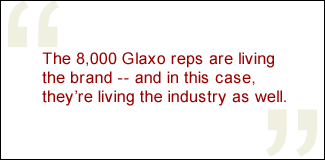A decision earlier in the year by GlaxoSmithKline appears to have taken the advertising industry by storm. Confronted by negative public images of the pharmaceutical industry, Glaxo has enlisted its 8,000 U.S. sales representatives to act as "public relations ambassadors." The company hopes that the reps' collective efforts will help to counteract these negative images and burnish the image of the industry generally -- and of GlaxoSmithKline in particular.
The decision was considered noteworthy by Advertising Age because this sort of image-polishing effort has typically taken the form of a high-profile corporate advertising campaign. Companies and industry groups have traditionally turned to public relations firms and advertising agencies when seeking to confront negative images. They've relied on professional communicators to get the job done through memorable ads and integrated communications campaigns. That's how oil companies, beer marketers, and tobacco producers have tackled the problem in the past.
So why has Glaxo taken a much-less-traveled road? Perhaps it's because the company has determined that what could be the most powerful communications weapon at their disposal -- their people -- will prove more credible than a 30-second commercial. What's more, enlisting Glaxo's employees as ambassadors might well add something that Gallup scientists have found to be crucially important when it comes to creating positive emotional bonds: the ability to personally connect with an audience. (See "Marketers: Don't Ignore Your Company's Employees" and "Living the Brand" in the "See Also" area on this page.)
Some observers have questioned the wisdom of this effort. There's concern that the army of Glaxo reps won't all speak with one voice. An ad campaign, in contrast, offers the company the promise of total message control. In the words of one senior marketer at another drug company, "I'm not sure I want eight thousand people on the ground given that level of responsibility."
Living the brand
Clearly there's the risk of multiple, even conflicting, communications. And it's hardly likely that all 8,000 sales reps will prove equally adept at delivering this new, "non-sales" image message. After all, sales reps are chosen because they can sell, not for their ability to deliver an industry PR image message.
In order to arm their troops with what Glaxo deems to be the requisite nuggets of supporting information, the company has created a short training module. Through this training, the company aims to reinforce sales rep credibility and equip the reps to respond to the sometimes thorny questions they may encounter. However, a 50-minute learning session, no matter how well designed, may not be enough to turn a sales pro into an industry spokesperson. So it's entirely possible that the net results of this sales force PR campaign may fall short of company expectations and requirements.
 |
Nevertheless, the upside potential clearly remains. The 8,000 Glaxo reps are, indeed, living the brand -- and in this case, they're living the industry as well. Regardless of whether the reps consistently deliver the same scripted message, this effort does add a human face to what is frequently an anonymous and fuzzy industry image. And a human face on the messenger raises the potential for a personal connection, the kind of connection a TV ad may struggle in vain to accomplish.
But there's a larger issue at play here as well, and it's a vitally important one. Some ad agency pros may register surprise at the Glaxo initiative, in part because they believe that real impact can best be achieved through centralized message design and delivery.
But Glaxo's sales reps -- like the employees of every other company around the globe -- already represent the brand and the industry to their friends, families, and communities. Regardless of whether companies acknowledge this fact, or whether they intentionally manage, equip, and empower their front-line employees to act as brand messengers, that's exactly what they are.
People represent the company's brand promise in ways that are both memorable and meaningful -- and they always have. As our research has shown, a company's brand representatives -- who may be tellers at a bank, checkout clerks in a supermarket, or sales reps calling on customers -- are in many cases the most important determinants of the strength and health of a company's customer relationships. They are the often-overlooked but always-crucial "fifth P" that must be added to the old customer relationship-building mantra of "Product, Place, Promotion, and Price." If a company is worried about its brand or industry image, why should it focus on its human touchpoints?
Imagine that Colgate took great pains to get the product exactly right, but ignored the package. So some packages were attractive, bright, and clean, while others were scruffy and uninviting, impossible to open, with labels and instructions that were unreadable. Or imagine that Nikon had produced a new camera, but each camera was different. Some were a pleasure to use and took wonderfully clear photos that you wanted to share with friends, while others were impossible to decipher and took fuzzy photos that made you want to warn your friends not to repeat your unhappy purchase.
Obviously, Colgate and Nikon wouldn't let this happen. These companies spend time and money to ensure that their packages and products are consistent. That's because their marketing departments know that the package and the product represent their brand. They speak volumes to customers about the company's brand promise.
Well, if there are people interacting with your customers on your behalf, they are every bit as important as your packaging or your product. Glaxo is simply embracing that marketing reality, and they certainly should not be alone in doing so. It's time to begin recognizing and leveraging the brand-enhancing power of that "fifth P."